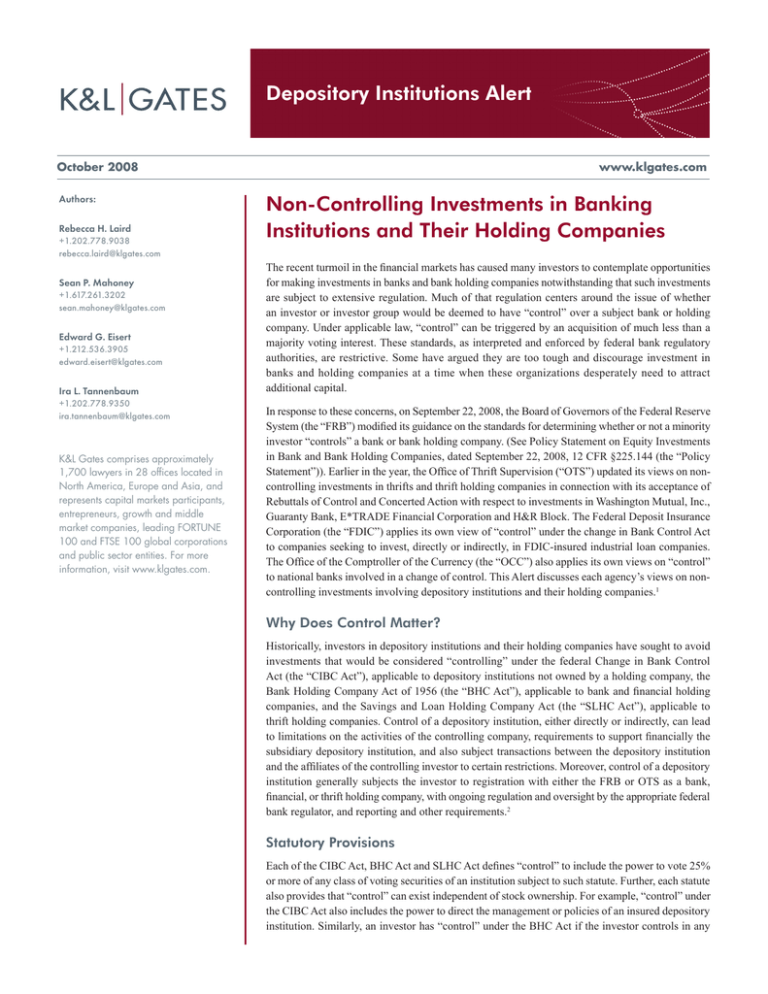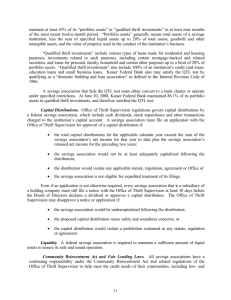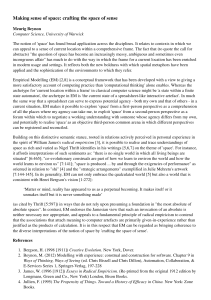
Depository Institutions Alert
October 2008
Authors:
Rebecca H. Laird
+1.202.778.9038
rebecca.laird@klgates.com
Sean P. Mahoney
+1.617.261.3202
sean.mahoney@klgates.com
Edward G. Eisert
+1.212.536.3905
edward.eisert@klgates.com
Ira L. Tannenbaum
+1.202.778.9350
ira.tannenbaum@klgates.com
K&L Gates comprises approximately
1,700 lawyers in 28 offices located in
North America, Europe and Asia, and
represents capital markets participants,
entrepreneurs, growth and middle
market companies, leading FORTUNE
100 and FTSE 100 global corporations
and public sector entities. For more
information, visit www.klgates.com.
www.klgates.com
Non-Controlling Investments in Banking
Institutions and Their Holding Companies
The recent turmoil in the financial markets has caused many investors to contemplate opportunities
for making investments in banks and bank holding companies notwithstanding that such investments
are subject to extensive regulation. Much of that regulation centers around the issue of whether
an investor or investor group would be deemed to have “control” over a subject bank or holding
company. Under applicable law, “control” can be triggered by an acquisition of much less than a
majority voting interest. These standards, as interpreted and enforced by federal bank regulatory
authorities, are restrictive. Some have argued they are too tough and discourage investment in
banks and holding companies at a time when these organizations desperately need to attract
additional capital.
In response to these concerns, on September 22, 2008, the Board of Governors of the Federal Reserve
System (the “FRB”) modified its guidance on the standards for determining whether or not a minority
investor “controls” a bank or bank holding company. (See Policy Statement on Equity Investments
in Bank and Bank Holding Companies, dated September 22, 2008, 12 CFR §225.144 (the “Policy
Statement”)). Earlier in the year, the Office of Thrift Supervision (“OTS”) updated its views on noncontrolling investments in thrifts and thrift holding companies in connection with its acceptance of
Rebuttals of Control and Concerted Action with respect to investments in Washington Mutual, Inc.,
Guaranty Bank, E*TRADE Financial Corporation and H&R Block. The Federal Deposit Insurance
Corporation (the “FDIC”) applies its own view of “control” under the change in Bank Control Act
to companies seeking to invest, directly or indirectly, in FDIC-insured industrial loan companies.
The Office of the Comptroller of the Currency (the “OCC”) also applies its own views on “control”
to national banks involved in a change of control. This Alert discusses each agency’s views on noncontrolling investments involving depository institutions and their holding companies.1
Why Does Control Matter?
Historically, investors in depository institutions and their holding companies have sought to avoid
investments that would be considered “controlling” under the federal Change in Bank Control
Act (the “CIBC Act”), applicable to depository institutions not owned by a holding company, the
Bank Holding Company Act of 1956 (the “BHC Act”), applicable to bank and financial holding
companies, and the Savings and Loan Holding Company Act (the “SLHC Act”), applicable to
thrift holding companies. Control of a depository institution, either directly or indirectly, can lead
to limitations on the activities of the controlling company, requirements to support financially the
subsidiary depository institution, and also subject transactions between the depository institution
and the affiliates of the controlling investor to certain restrictions. Moreover, control of a depository
institution generally subjects the investor to registration with either the FRB or OTS as a bank,
financial, or thrift holding company, with ongoing regulation and oversight by the appropriate federal
bank regulator, and reporting and other requirements.2
Statutory Provisions
Each of the CIBC Act, BHC Act and SLHC Act defines “control” to include the power to vote 25%
or more of any class of voting securities of an institution subject to such statute. Further, each statute
also provides that “control” can exist independent of stock ownership. For example, “control” under
the CIBC Act also includes the power to direct the management or policies of an insured depository
institution. Similarly, an investor has “control” under the BHC Act if the investor controls in any
Depository Institutions Alert
manner the election of a majority of the directors, or the
FRB determines that the investor exercises a controlling
influence over management. The SLHC Act provides that
an investor controls a thrift or thrift holding company if the
investor controls in any manner the election of a majority of
the directors of such institution, or if the OTS determines
that the investor exercises a controlling influence over such
institution. Control of a thrift holding company under the
SLHC Act also exists if the investor has contributed more
than 25% of the capital of the company. The one explicit
statutory standard on non-controlling investments comes
in the BHC Act, which provides a presumption that any
company that owns, controls, or has power to vote less than
5% of any class of voting securities of a bank or bank holding
company does not “control” that institution.
The issue of control becomes murky when the investment
is more than 5% but less than 25% of any class of voting
securities of a banking institution or its holding company.
To deal with the gray area between the two numerical
poles in the statutes, the regulatory agencies have adopted
rebuttable presumptions of control which exist when an
investor owns, holds or controls 10% of more of the voting
securities of a banking institution or holding company, the
bank or other company has registered securities under the
Securities Exchange Act of 1934 and no other person will
own, control, or hold the power to vote a greater percentage
of that class of voting securities. The FRB and OTS apply
additional presumptions of control.3 If control is presumed,
an investor generally must make a filing with the applicable
regulator to rebut control. Such filing will usually include
an agreement or commitments that are consistent with the
regulator’s understanding of how a passive, non-controlling
investor would behave.
FRB Control Concepts
With respect to investments in banks or in bank holding
companies, the FRB routinely has found that an investor
that owns less than 25% of any class of voting securities
of a bank or bank holding company does not control the
institution if the investor makes certain commitments
(referred to as “Crownx Commitments”) to remain passive.
These undertakings include commitments to refrain from,
among other things:
• seeking or accepting representation on the board of
directors of the subject bank or holding company or any
of their respective subsidiaries, unless the investment
is less than 15% of any class of outstanding voting
securities and the investor is not the largest investor of
the subject bank or holding company;
• attempting to influence major policies or plans of the
subject bank or holding company; and
• entering into any other banking or non-banking
transactions with the subject bank or holding company
or any of their respective subsidiaries, other than de
minimis transactions.
The Policy Statement provides investors additional flexibility
in structuring an investment without being deemed to acquire
control of the bank or bank holding company. The Policy
Statement allows investors to do the following without being
deemed to control the bank or bank holding company in
which the investment is made:
• have one director on the board of the bank or bank
holding company;
• have two directors on the board of the bank or bank
holding company if such representation does not
constitute 25% or more of the voting directors and
another shareholder of the bank or bank holding
company is a bank holding company that controls
such institution;
• own up to one-third of the total equity capital of the
bank or bank holding company provided that the
investor does not own, hold or vote more than 15% of
the outstanding shares of any class of voting securities
of the institution;
• engage in discussions with management over
major policies;
• engage in business transactions with the bank or
holding company on a limited basis, as reviewed on a
case-by-case basis, and generally on market terms, nonexclusive and terminable without penalty; and
• invest in non-voting securities, subject to covenants
prohibiting the target bank or holding company from
issuing senior securities, changing the security terms or
liquidating the organization.
In summary, the Policy Statement provides additional
flexibility in structuring non-control investments.
Nevertheless, minority non-controlling investments in banks
and bank holding companies cannot provide to investors
many of the features of other private equity investments, such
as the ability to exercise a controlling influence over major
policies or strategic decisions.
October 2008 | 2
Depository Institutions Alert
OTS Control Concepts
FDIC Control Concepts
The OTS, like the FDIC and the OCC, has long allowed
investors to own more than 10% of the outstanding voting
shares of a thrift or thrift holding company (e.g., up to 25%
of the outstanding voting shares), provided that the investor
rebutted control by submitting a rebuttal of control in writing
and by entering into a standardized rebuttal agreement, set
out in the OTS regulations. A rebuttal of control is generally
filed when an investment reaches 10% of any class of voting
securities of a thrift or thrift holding company and another
control factor is present. As in the case of the Crownx
Commitments, the “standard” rebuttal agreements provide
that the investor will not, among other things:
Against the backdrop of applications filed by retailers to
acquire industrial loan companies in recent years, the FDIC
proposed regulations in early 2007 to regulate for the first
time companies that control industrial loan companies.
These regulations specifically address control issues by
incorporating regulations promulgated under the CIBC
Act. In recent approval orders relating to the acquisition of
industrial loan companies by companies that are not bank
holding companies, the FDIC has also required investors
owning more than 10% but less than 25% of the voting shares
of the acquiring company to execute passivity agreements.
These agreements provide that the FDIC would not find the
investor to control the target industrial loan company if the
investor refrained from the following, among other things:
• seek or accept representation through more than one
member of the board of directors of the thrift or thrift
holding company;
• engage in any intercompany transaction with the target
thrift or thrift holding company or any of its affiliates;
• have or seek to have any representative serve as the
chairman of the board of directors, or chairman of an
executive or similar committee; or
• seek or accept access to any non-public information
concerning the thrift or thrift holding company.
Recent orders by the OTS have evidenced flexibility in
applying the model terms of the OTS form of rebuttal
agreement. For example, investors in Washington Mutual,
Inc. were permitted to acquire 24.99% of the voting power of
that company, have representation on the board of directors
by one director and have a right to another non-voting
observer, without being deemed to control the company.
With respect to E*TRADE Financial Corporation, the OTS
permitted investors to seek or accept access to non-public
information so long as such information was not material.
The order pertaining to Guaranty Bank permitted the subject
thrift to engage in transactions with companies in which
the investor owned less than 10% of the outstanding voting
securities. The Acceptance of Rebuttal of Control pertaining
to H&R Block, Inc., a thrift holding company, permitted the
investor to engage in certain intercompany transactions with
H&R Block where such transactions were entered into on an
arm’s-length basis, in the ordinary course of business and at
market rates and terms.
While the OTS has already shown flexibility in structuring
non-controlling investments in thrifts, it remains to be seen
whether the Policy Statement will affect how the OTS views
control in the future.
• having more than one representative on the board
of directors of the parent company or any of its
subsidiaries, so long as the investor does not have any
representatives on the board of the bank; or
• entering into any other banking or non-banking
transactions with the target bank or holding company
or any of their respective subsidiaries, other than de
minimis transactions.
The FDIC passivity agreements appear to be modeled
after the FRB Crownx Commitments. This has become
more important as significant investments in commercial
firms that own industrial loan companies (e.g., HarleyDavidson, Inc. owns an industrial loan company) may pose
issues for investors in those companies. It remains to be
seen whether the FDIC will revise its form of passivity
agreement to conform to the new standards set forth in the
Policy Statement.
OCC Control Concepts
The OCC regulates national banks, including full-service
banks, limited purpose trust companies and certain credit
card banks. With respect to investments in commercial firms
that control national credit card banks (e.g., retailers) or
national trust companies, or other national banks that are
not wholly-owned by a bank holding company or financial
holding company, the OCC would have the regulatory
authority to determine whether such investments constitute
control. In its Change in Bank Control manual, the OCC
describes the commitments that it requires in connection
with a rebuttal of control in connection with an investment
in a national bank.
October 2008 | 3
Depository Institutions Alert
These commitments include that:
The Landscape Remains Complex
• the investor will not serve on the board of directors and
will not nominate any candidate to serve on the board
of the national bank;
Even with welcome developments providing greater clarity
and flexibility to investors in structuring minority equity
investments in depository institutions and their holding
companies, the legal landscape remains complex and
somewhat uncertain. The rules and procedures applied still
differ from regulator to regulator—as do presumptions of
control. Each investment must be analyzed individually
based upon the specific facts presented and there is unlikely
to be a universal approach that will work with all investments
and institutions. Above all else, regulators continue to remind
investors that they retain the discretion to make decisions on
a case-by-case basis.
• the investor will have only limited contacts with
bank management that are customary for interested
shareholders; and
• the investor will engage only in normal and customary
banking transactions with the bank.
As of the date of this writing, the OCC has not indicated
whether it will revise its control concepts to accord the same
flexibility provided by the FRB and the OTS.
October 2008 | 4
Depository Institutions Alert
Endonotes
1 Many states also have laws regulating changes in bank control
or who can control banks and other financial institutions.
2 Control of certain entities, such as industrial loan companies,
credit card banks and limited purpose trust companies, does
not require the controlling owner to register as a holding
company under the BHC Act because those entities are not
considered “banks” under the BHC Act.
3 The other presumptions of control under regulations
promulgated by the FRB are as follows:
• A company controls the bank or other company if it enters
into any agreement or understanding with a bank or other
company (other than an investment advisory agreement),
such as a management contract, under which the first
company or any of its subsidiaries directs or exercises
significant influence over the general management or
overall operations of the bank or other company.
• A company that, together with its management officials
or controlling shareholders (including members of the
immediate families of either), owns, controls, or holds with
power to vote 25% or more of the outstanding shares of
any class of voting securities of a bank or other company
controls the bank or other company, if the first company
owns, controls, or holds with power to vote more than 5%
of the outstanding shares of any class of voting securities
of the bank or other company.
• A company that has one or more management officials in
common with a bank or other company controls the bank
or other company, if the first company owns, controls or
holds with power to vote more than 5% of the outstanding
shares of any class of voting securities of the bank or other
company, and no other person controls as much as 5% of
the outstanding shares of any class of voting securities of
the bank or other company.
The OTS also presumes control if the acquiror owns more
than 10% of any class of voting securities of a thrift or thrift
holding company and any one of the following factors
is present:
• The acquiror would be one of the two largest holders of
any class of voting stock of the thrift;
• The acquiror would hold more than 25% of the total
stockholders’ equity of the thrift;
• The acquiror would hold more than 35% of the combined
debt securities and stockholders’ equity of the thrift;
• The acquiror is party to an agreement: (a) pursuant to
which the acquiror possesses a material economic stake in
the thrift resulting from, among other things, the provision
of essential services to the thrift; or (b) that enables the
acquiror to influence a material aspect of the management
or policies of the thrift (subject to certain exceptions);
• The acquiror would have the ability, other than through the
holding of revocable proxies, to direct the votes of more
than 25% of a class of the thrift’s voting stock or to vote
more than 25% of a class of the thrift’s voting stock in the
future upon the occurrence of a future event;
• The acquiror would have the power to direct the
disposition of more than 25% of a class of the thrift’s
voting stock in a manner other than a widely dispersed or
public offering;
• The acquiror and/or the acquiror’s representatives or
nominees would constitute more than one member of the
thrift’s board of directors; or
• The acquiror or a nominee or management official of
the acquiror would serve as the chairman of the board
of directors, chairman of the executive committee, chief
executive officer, chief operating officer, chief financial
officer or in any position with similar policymaking
authority in the thrift.
K&L Gates comprises multiple affiliated partnerships: a limited liability partnership with the full name K&L Gates LLP qualified in Delaware and
maintaining offices throughout the U.S., in Berlin, in Beijing (K&L Gates LLP Beijing Representative Office), and in Shanghai (K&L Gates LLP Shanghai
Representative Office); a limited liability partnership (also named K&L Gates LLP) incorporated in England and maintaining our London and Paris
offices; a Taiwan general partnership (K&L Gates) which practices from our Taipei office; and a Hong Kong general partnership (K&L Gates,
Solicitors) which practices from our Hong Kong office. K&L Gates maintains appropriate registrations in the jurisdictions in which its offices are
located. A list of the partners in each entity is available for inspection at any K&L Gates office.
This publication/newsletter is for informational purposes and does not contain or convey legal advice. The information herein should not be used or
relied upon in regard to any particular facts or circumstances without first consulting a lawyer.
Data Protection Act 1998—We may contact you from time to time with information on K&L Gates LLP seminars and with our regular newsletters,
which may be of interest to you. We will not provide your details to any third parties. Please e-mail london@klgates.com if you would prefer not to
receive this information.
©1996-2008 K&L Gates LLP. All Rights Reserved.
October 2008 | 5







